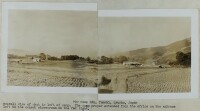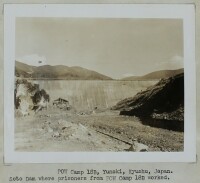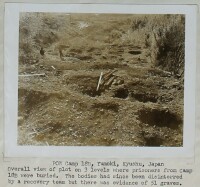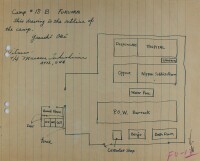| Fukuoka
POW Camp #18-B Yunoki, Sasebo |
Main Index Camp List
| Fukuoka
18-B (SASEBO KAIGUN SHISETSU-BU) NAGASAKI-ken, MATSUURA-gun, YUNOKI-mura Satellite map Aerial (Nov. 1947; courtesy of Japan Map Archives) Area map Timeline: 12 Oct 1942: Navy Cpl. Sachio Egawa, supervising "We arrived at Camp No. 18 the 14th of October 1942 and stayed there for eighteen months. Most of our fellows died there. We lost, thirty-five men in March 1943. We were divided in groups of twenty men. In March 1943 we lost six of our group. They all died of pneumonia. The Japanese worked us terrifically long hours. One time they worked us thirty-six hours without sleep. We worked in a rock quarry." - from Rogge Report 10 Oct 1943: Army took over camp (from Navy) under command of 2nd Lt. Uichi Ikegami 17 Apr 1944: Camp closed; 100 surviving prisoners transferred to Fukuoka 1-B to work on construction of Mushiroda Air Field (later called Itazuke Air Field) Camp layout Description by Japanese scholar Toru Fukubayashi, Translated by Yuka Ibuki (Used with permission) Soto Branch Camp (Fukuoka 18-B) A temporary POW Camp was established at Yunoki-mura, Kitamatsuura-gun (current Yunoki-cho, Sasebo City), Nagasaki Prefecture in December 1942 and the POWs taken from Fukuoka POW Camp. [They] were forced to work for the construction of Soto Dam by Sasebo Naval Hdqs. Established to be Fukuoka No.18 Branch Camp on October 10, 1943. Closed on April 17, 1944 when the dam was completed, and the POWs were transferred to Fukuoka No.1 Branch Camp. The POWs were used by the Facility Department of Sasebo Naval Hdqs. 53 POWs died while imprisoned. [Many more died shortly after camp was closed as a direct result of conditions at Sasebo.] Photos: Pics of Sasebo #18 taken at end of war: FUK-18_Lookout_area_at_Soto_dam Battle_of_Wake_Island_memorial - Wake Island flag - courtesy of Barry Kelso |
Labor: Slave labor utilized by Japanese Naval HQ, Facilities Department, to build facilities. Also a large detail (245 POWs, 132 survived) used for construction and quarry work at the Soto Dam. Very harsh conditions and excessive death rate due to malnutrition and poor housing. Men were mostly civilians from Wake Island who were from the third shipment from Wake Island on the Tachibana Maru (see Rogge Report). Camp Reports - original document containing general and investigative reports, and narrative by Investigating Officer 2nd Lt. Melvin Cohn (Team #10) FUK-18 Assorted Documents (RG 331 Box 925) FUK-18 Japanese documents with English translation (RG331 Box 925) Detailed Report on Circumstances Attending Capture of H.M.S. "Mata Hari" - Reports on Prisoner of War Camps by Lt. A. C. Carston, Commanding Officer of HMS Mata Hari (courtesy of Jonathan Moffatt) - detailed reports on Sasebo Ainoura transit camp (page 3, bottom) and Camp #18 (pages 5 and 6). The Ainoura camp was located at Ainoura Jr. High School (aerial photo, Apr. 1948, courtesy of Japan Map Archives). Wilcox Diary Hell Ship: Tachibana Maru - departed Wake with some 200 civilian POWS on 20 Sept 1942. Arrived Moji 30 Sept 1942. Men at this camp: (all ex-Wake Island civilians) Edgar Franklin Burns - affidavit of Wake civilian produced for the War Crimes Trials. Very extensive description of the camp and work conditions. Peter W. Hansen (Wake civilian - died 45.03.21) Donald M. Williams (deceased) - a remarkable tribute from his sister Affidavits (RG331 Box 925) - Burns, Brooks, Bowen, Barney, Barnett, Arambarri, Anderson, Akiyama (Japanese orderly, guard), Patrick Kahaumea Aki Patrick Aki interview - Aki was at the Sasebo camp from Oct. 1942; at Fukuoka #1 from Apr. 1944; at Fukuoka #2 from Dec. 1944; at Fukuoka #6 from June 1945 until liberation. Interesting article relating when he suddenly met an old friend from Hawaii, Fumitane Jibutsu, who almost became his executioner. Rosters: READ FIRST! Notes on rosters, confirmed complete death roster (by author Bonnie Gilbert) Rosters - original documents, includes Document Inventory List, Roster of Allied POWs (British and US military, civilian), Death List, Detailed Rosters, Temporary Camp Roster Archival documents: FUK-18_Death_roster_RG407_Bx187
Roster
of
deceased from Japanese
RecordsFUK-18_Death_certificates_RG407_Bx187 FUK-18_Death_certificates_RG331Bx925 List of dead Soto Dam new plaque - photo of memorial plaque to reflect correct death roster; Sasebo City historical site sign (in Japanese) More on Soto Dam Japanese Personnel: "From October 1942 until October 1943 a Japanese Naval Officer named Igawa [Egawa] whose rank was Haso (I do not know the corresponding rank in the U.S. Navy) was in charge. From October 1943 until April 1944 Camp 18 was under the supervision of the army and an officer named Ikegami whose rank was shoi (major) was in command." - Warren Otto Rogge, carpenter and mill wright, Wake Island civilian FUK-18 Japanese personnel FUK-18 J-civilian chart and treatment of POW's - documents showing organizational chart of Japanese civilians in charge with an explanation of the treatment of POW's (Japanese with English translation) Nakamura, Kiyoteru - construction engineer See also roster of all Fukuoka Camp Group commanders. Sachio Egawa statements (PDF, English and Japanese) - re POW's under jurisdiction of Sasebo Naval Civil Engineering Dept.: "I believe it is my duty to tell
the truth about the conditions of the prisoners of war who
received
truly pitiful treatment in internment..."
"The prisoners were improperly handled... such completely irresponsible behavior deserves careful investigation." War Crimes Trial Reviews (original documents): IMTFE_Case23_IKEGAMI - FUK-18 IMTFE_Case94_EGAWA, FUKUDA, ORITO, WATANABE - FUK-18 SPECIAL
PAGE
ON SASEBO HISTORY:
|




